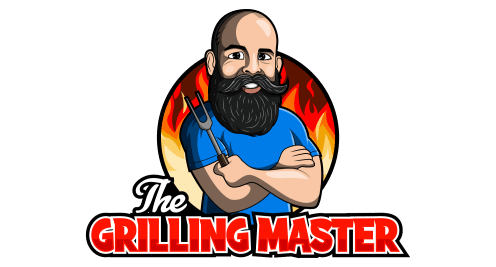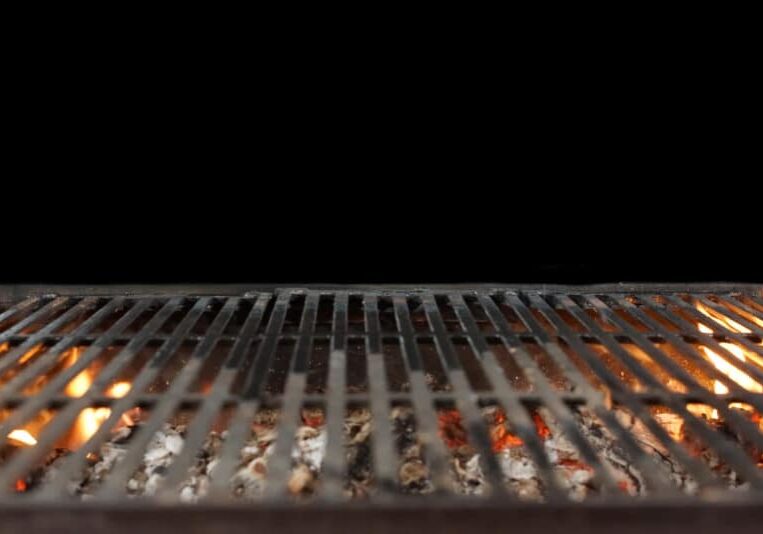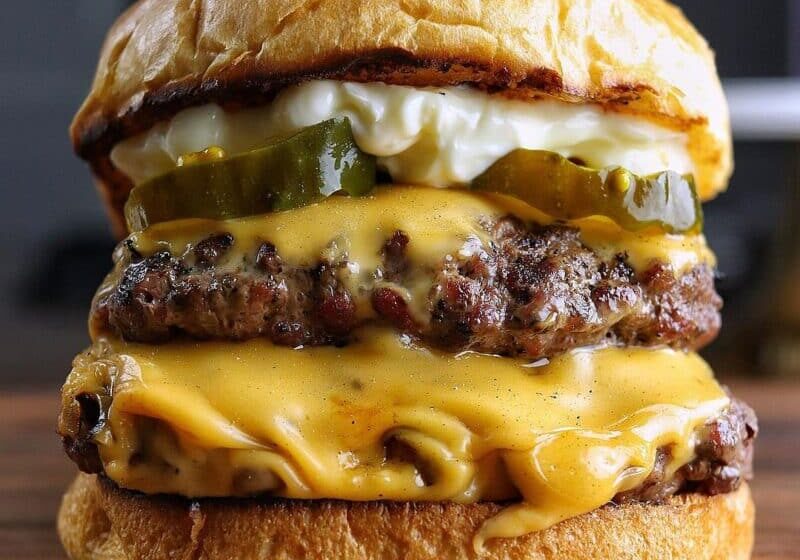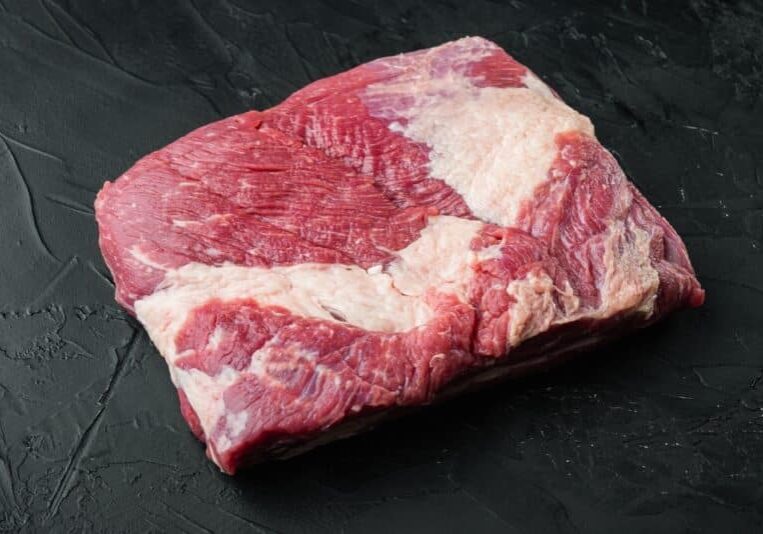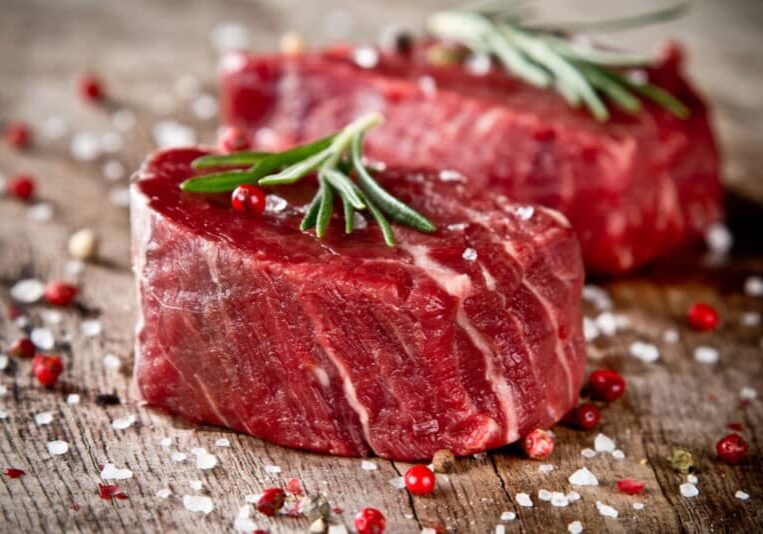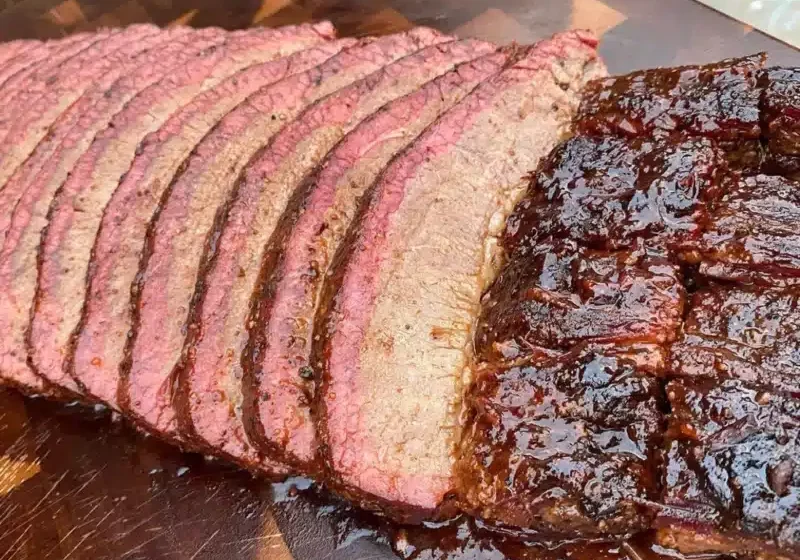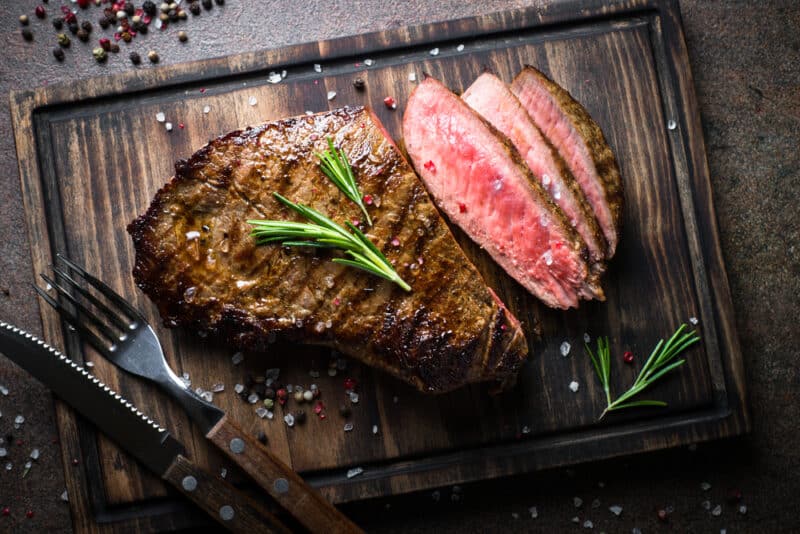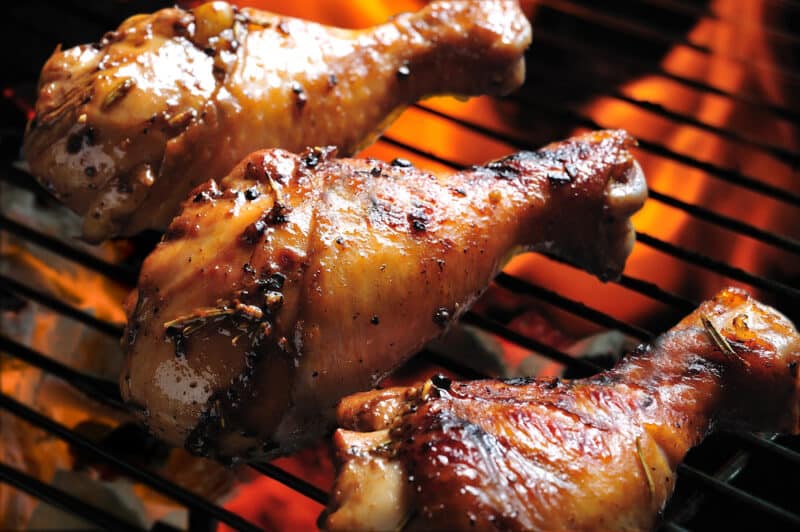How to Slice Brisket for Maximum Flavor!
TheGrillingMaster.com is reader-supported. If you buy something using the links on our site, we might earn an affiliate commission at no added cost to you. This helps us pay our staff to keep making awesome content for you!
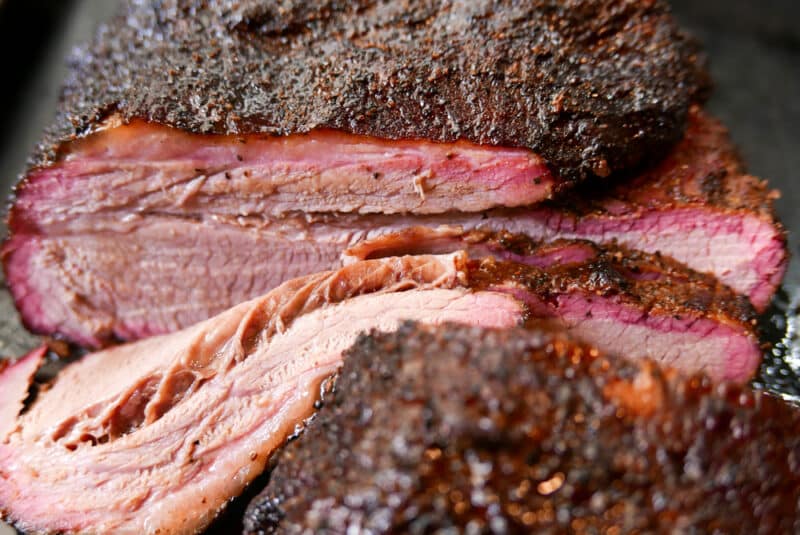
Knowing how to slice brisket correctly is crucial if you want to avoid ruining your masterful work on the smoker. It’s taken a lot of time and effort to get that black bark and that jiggle that tells you it’s perfectly done, and you don’t want to serve dry, chewy brisket.
But don’t stress, slicing a brisket is not rocket science. With the tips in this step-by-step guide, you’ll soon be the BBQ king on the block.
What is a Brisket?
Before we get to how to slice a brisket, let’s make sure those who are new to spending the most part of a day smoking the perfect brisket understand what all the fuss is about,
A complete full-packer brisket is taken from the lower chest of the animal and comprises two main overlapping muscles with grains running in different directions. And that is what the fuss is about. Slicing meat at a 90-degree angle across the grain can mean the difference between juicy and tender or tough and chewy, especially a tough cut of beef like brisket.
When you buy a brisket, you can either buy each section separately or buy the whole brisket, which weighs between 12 and 18 pounds. That makes the brisket the largest cut of meat that many people will ever attempt to prepare at home.
|
Name |
Also Called |
Which Part |
Used For |
|
Whole Brisket |
Full Packer |
2 parts often smoked as one |
|
|
The Point |
The Deckle |
The fatty part |
Great for making Burnt Ends |
|
The Flat |
First Cut |
The leaner part |
Best for practicing smoking and slicing skills |
When you shop for brisket at your local supermarket, you’re unlikely to find a full-packer brisket. Instead, you’ll find the two parts of the brisket packed separately, with the brisket flat being more readily available.
The Brisket Point
The point, or deckle, is a fattier cut of meat that might be harder to find as a whole cut of meat at supermarkets. You might find the point chopped into chunks.
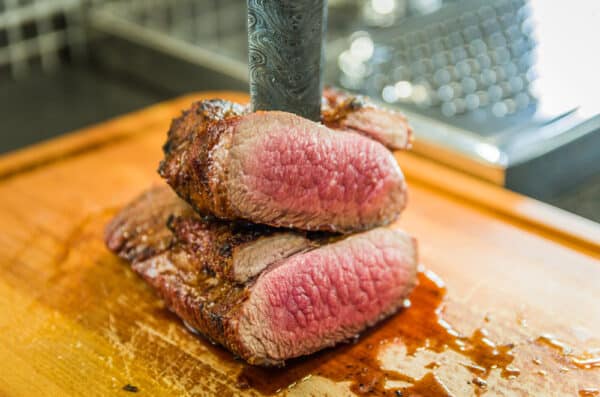
Brisket Point
The Brisket Flat
When you get a pre-cut brisket, it will usually be the leaner brisket flat, or first cut, which is best served sliced.
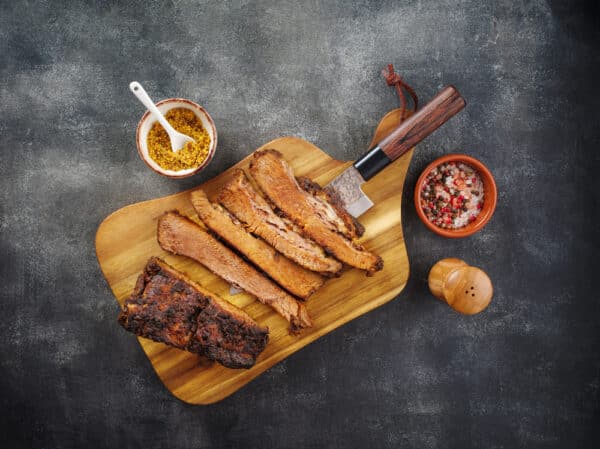
Brisket Flat
The Role of the Fat in Brisket
A good brisket has visible marbling layers. That’s where most juice and flavor come from. Many brisket recipes tell you to trim off most of the fat before smoking or grilling the meat. You can trim excess fat with a sharp knife. The fat is easier to cut through when the brisket is still cold.
However, to make sure your brisket’s juiciness and flavor, I recommend leaving about a quarter inch of fat on the outside. That will keep the brisket juicy during the many hours of exposure to heat, and you can then trim excess fat before you slice the beef.
For me, eating fatty brisket makes me hear the angels sing, but I know many people who love lean slices of brisket, and they’ll choose them every time.
Related Reading>> Learn how to re-heat brisket.
How Much Brisket to Buy
When you plan your smoked brisket get-together, you’ll want to make sure you have enough to go around for every guest at your planned BBQ. The rule of thumb is 1/2 pound of raw brisket per person.
However, keep in mind that about 25% of the weight of an uncooked brisket is the fat cap that you might want to trim off – before or after cooking. Therefore, you’d be wise to consider this when calculating how much brisket to buy.
Related Reading>> Get the best brisket taco marinades.
How to Slice Brisket – Timing Matters
The timing of when you slice your beef brisket is very important. Wait until you’re ready to eat it before you slice it. Sliced brisket deteriorates quickly after it is cut. I usually slice only as much as necessary, rather than having sliced leftover brisket go dry in the fridge. I prefer to slice more for those who want seconds.
Here’s what well-known pitmaster Aaron Franklin says: “Once you start slicing the brisket and the meat is exposed to the air, it will immediately start to oxidize. You only have a limited amount of time with it in its perfect state, so hold off on slicing until you’re ready to serve.”
5 Step Method for Slicing Brisket
1. Prepare the Brisket:
- Ensure the brisket is fully rested.
- Position it on a large cutting board with the point facing your non-dominant hand.
2. Separate Point from Flat:
- Use your non-dominant hand to feel the fat layer separating the two parts.
- Make an initial cut along this fat layer, ensuring the flat and point are now separate pieces for distinct slicing.
3. Slicing the Flat:
- Start with the flat portion of the brisket.
- Ensure uniform 1/4-inch slices against the grain for an ideal serving size.
4. Slicing the Point:
- Take the point and slice it in half opposite to your first cut.
- Turn one half 90 degrees and slice against the grain in 1/4-inch slices, similar to the flat.
- Repeat the slicing process with the other half, ensuring you always slice against the grain.
5. Serve and Enjoy:
- Arrange your perfectly sliced brisket on a serving platter.
- Complement it with your preferred brisket fixings and savor every bite!
Why Should You Rest the Brisket Before Slicing it?
Before you even consider slicing the brisket, allow it to rest for at least one, but preferably two hours to let the juices redistribute and let the collagen or connective tissue in the muscle fibers break down to increase juiciness and tenderness.
Keep an eye on the internal temperature while resting the brisket. The USDA recommends keeping beef at a minimum temperature of 145 °F. If the internal temperature of the meat drops below this, it enters the danger zone and then there is an increased risk of food poisoning.
If the meat is immediately sliced after grilling, it will become dry as moisture will be lost. This happens due to the reaction of proteins in the meat during the cooking process. Raw beef contains approximately 75% water, which gets squeezed out of the meat when the proteins start to contract as they cook.
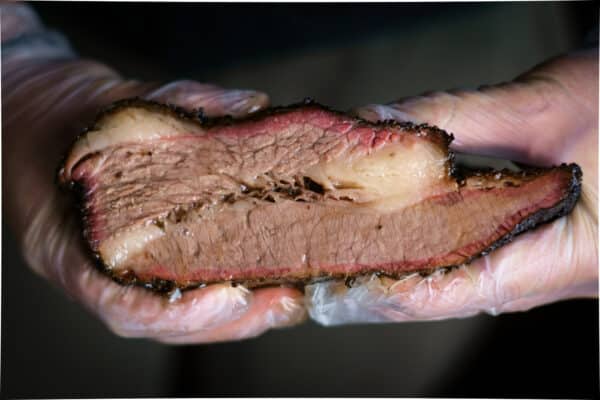
Smoked Brisket
The contraction starts with a decrease in diameter, and when the temperature goes above 120°F, it also causes the proteins to shrink in length. As a result, the proteins can lose up to 50% of their length, leading to a loss of moisture and the release of the juices when the meat is cut.
Remove the cooked brisket from the smoker when the internal temperature reaches 195°F, to allow carry-over cooking to raise the temp to about 203 to 205°F while it rests.
What You Need for Slicing Brisket
I find it’s best to get everything ready before the brisket slicing starts because it has to happen at the last moment before serving the guests. Here’s what you’ll need:
Butcher’s Block
A butcher’s block is heavy enough to sit in one place. However, if you use a cutting board that slides around as you slice, a wet kitchen towel under the board will resolve the issue.
The board you use must be large enough to accommodate the large piece of meat.
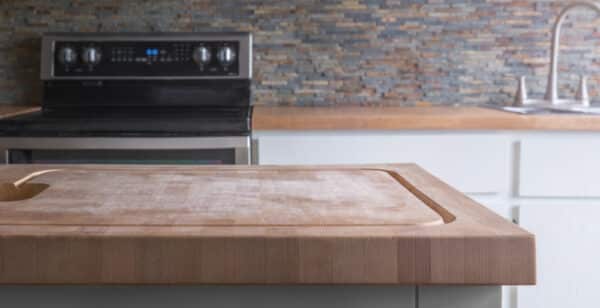
Butchers Block
Sharp Slicing Knife
According to Aaron Franklin, a suitable brisket knife that will cut through the crispy bark without destroying it is a serrated knife with a 12 or 14-inch blade. Fewer strokes are needed with a longer blade. The blade should have a sharp serrated edge. but not the small ridge-like teeth that you see on bread slicers.
You’ll also need a fork or meat gloves to hold the brisket in place while slicing it.
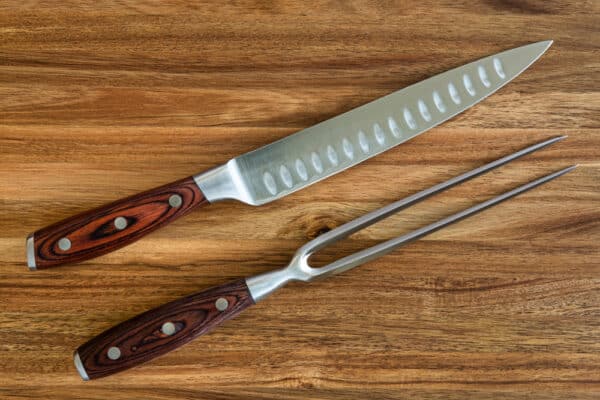
Long Blade Serrated Knife and Meat Fork on Cutting Board
How to Slice Brisket Across the Grain
Finally, we are ready to slice the brisket!
This is also the time to trim any excess fat if you didn’t do it before smoking the brisket.
The most important thing is the direction of your meat’s grain and the direction of the slices you cut. As mentioned already, the brisket has two parts, each with its own grain direction, which can make this a little tricky, as you want to cut against the grain.
The grain of a piece of meat is the alignment of muscle fibers that are strong and chewy while intact. When you slice against the grain, you break up the long muscle fibers, making them less chewy with every cut you make.
Some pit masters recommend cutting a corner of the flat before cooking the brisket, as it is easier to identify the grain direction when the meat is raw. You can then use that corner to help you find the grain direction when the brisket is done resting and ready to be sliced.
There are two options — one for the experienced and one for the inexperienced grill masters.
How to Slice a Whole Packer Brisket
Experienced grill masters can tackle the entire brisket and slice against the grain of the meat even though the grain of the flat and point runs in opposite directions.
Here’s how they do it:
Start by cutting off the hard, dry tip that is typically somewhat overcooked. You can keep that to dice up as burnt ends.
Start on the brisket flat, using your sharp serrated knife to slice across the grain at a 90° angle in long, smooth strokes, making slices about the thickness of a No.2 pencil.
When you get to the middle of the Packer, you’ll start noticing the second layer of muscle fibers running in a different direction. This is the brisket point.
Stop cutting and rotate the meat about 90 degrees before you continue slicing. You will now be cutting against the grain of the brisket point.
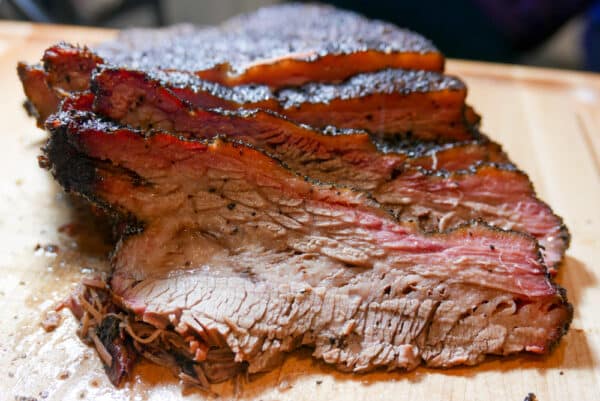
Brisket showing different grain directions
How to Slice Brisket Flat and Point Separately
For first-timers, it’s helpful to separate the brisket point and flat parts, so you have two separate pieces to slice. Because grain runs in different directions in each section, you’ll make sure you’re cutting against the grain.
To separate the point and flat of the brisket, place your hand gently on the brisket’s point and move it circularly. The fat layer should help you feel the separation between the two pieces.
You can then make the first slice to separate them by locating where the point meets the flat.
For cutting, start with the flat section and slice it thinly against the meat’s grain. The ideal size of the slices should be just under half-inch or similar to a No. 2 pencil.
While slicing, make firm but gentle, smooth strokes at a 90-degree angle from top to bottom, much like slicing a loaf of bread.
When you’re done with the flat, move on to the point section and pay attention to the meat’s grain direction. Cut the point thinly against the grain, as with the flat section.
HACK: Jim Budros, a pit master and restaurateur from Ohio, suggested a different approach to slicing brisket. He divides the point and flat sections of the meat by removing the fat between them and then realigns them.
This involves rotating the point section by 60 degrees so that the meat fibers are all aligned in the same direction. By doing this, it becomes possible to cut the meat across the grain from top to bottom.
Related Reading>> See the best internal temp for Brisket.
Save the Burnt Ends
When you slice smoked brisket, the beginning and end sections, also called burnt ends, may be too small to slice like the rest. However, don’t discard these flavorful pieces.
Despite the difficulty in slicing them against the grain, they would still be exceptionally soft and juicy. Instead, cut them into smaller chunks and serve them together with the rest of the brisket or keep them aside for a later indulgence.
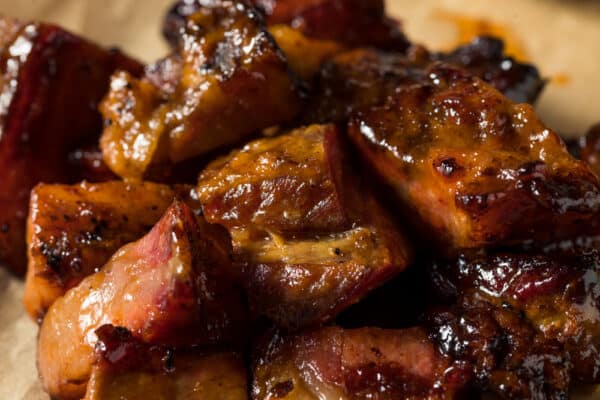
Burnt Ends
Bottom Line
So, there you have it folks! Whether you’re in Texas or elsewhere, slicing a brisket against the grain is a crucial factor in making sure your beef is as tender and juicy as possible. Armed with a sharp, serrated, long-blade knife, you’re now ready to impress your friends and family with your expertly sliced brisket. Remember to take your time, be patient, and always slice against the grain. Happy grilling!
Frequently Asked Questions
Here are some frequently asked questions and answers about slicing smoked brisket:
Q: What is a brisket?
A: Brisket is a cut of beef that comes from the breast section of the cow. It is a tough, flavorful cut that is often used for smoking and barbecuing.
Q: How do I know when my smoked brisket is ready to slice?
A: The internal temperature of the brisket should be around 195°F when you pull it off the smoker to allow carry-over cooking to raise to the ideal internal temp of 200-205°F while you let it rest. You can use a meat thermometer to check the temperature.
Q: How do I slice a smoked brisket?
A: You should slice against the grain of the meat to ensure that it is tender. Start by cutting off any excess fat or burnt ends, and then slice the brisket thinly (about 1/4 inch thick) against the grain.
Q: What tools do I need to slice a smoked brisket?
A: You will need a sharp carving knife with a long, serrated blade, a large cutting board, and a pair of meat gloves or tongs to hold the brisket while you slice it.
Q: How should I store leftover smoked brisket?
A: You can store leftover smoked brisket in an airtight container in the refrigerator for up to 4 days, or in the freezer for up to 3 months.
Q: Can I slice my smoked brisket ahead of time?
Slicing your smoked brisket ahead of time is not recommended. It’s best to wait until just before serving to ensure that it stays moist and tender because once you start slicing the brisket and the meat is exposed to the air it will immediately start to oxidize.
Q: How do I reheat sliced smoked brisket?
A: You can reheat sliced smoked brisket in the microwave, oven, or on the stovetop. Wrap it in foil to keep it moist, and heat it until it reaches an internal temperature of 165°F.
Learn More About Grilling
If you want to learn more about grilling, check out these other helpful resources!

Kevin Turner
Hi there, I'm Kevin Turner, Founder and CEO of thegrillingmaster.com. I started this website to share my passion and knowledge with you. You can leverage my years of experience as a pit master and professional to grill great food!
About The Grilling Master
Hi there, I'm Kevin Turner, Founder and CEO of thegrillingmaster.com.
My passion has always been grilling, smoking and BBQ delicious meats that satisfy my inner carnivore!
I started this website to share my passion and knowledge with you, the hungry reader who wants to prepare the perfect meal.
You can leverage my years of experience as a pit master and professional.
Send me a message and let's connect on Twitter here.
